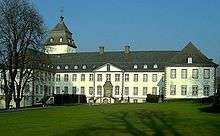Schmallenberg
| Schmallenberg | ||
|---|---|---|
|
Schmallenberg (with “St. Alexander” Catholic church) | ||
| ||
 Schmallenberg | ||
Location of Schmallenberg within Hochsauerland district 
 | ||
| Coordinates: 51°08′0″N 08°18′0″E / 51.13333°N 8.30000°ECoordinates: 51°08′0″N 08°18′0″E / 51.13333°N 8.30000°E | ||
| Country | Germany | |
| State | North Rhine-Westphalia | |
| Admin. region | Arnsberg | |
| District | Hochsauerland | |
| Government | ||
| • Mayor | Bernhard Halbe (CDU) | |
| Area | ||
| • Total | 303.00 km2 (116.99 sq mi) | |
| Population (2015-12-31)[1] | ||
| • Total | 25,230 | |
| • Density | 83/km2 (220/sq mi) | |
| Time zone | CET/CEST (UTC+1/+2) | |
| Postal codes | 57392 | |
| Dialling codes | 02971, 02972, 02974, 02975, 02977 | |
| Vehicle registration | HSK | |
| Website | www.schmallenberg.de | |
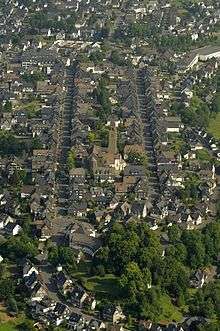
Schmallenberg (Westphalian: Smalmereg) is a town and a climatic health resort in the High Sauerland District, Germany. Relating to its size of 117 square miles (303 square kilometers) it is the third biggest of all cities and towns of the state of North Rhine-Westphalia and the second biggest of Westphalia. It also has the biggest area of all cities and towns in North Rhine-Westphalia that are not independent but belong to a district.
With Schmallenberg central town and the Kneipp health resort of Bad Fredeburg the town has two urban settlements. Additionally, 81 villages belong to the town's territory. Also being called “the Schmallenberg Sauerland”, the Town of Schmallenberg is famous for its total of four[2] health resorts and nine[3] villages which have been awarded gold for their beauty in the nationwide “Our village has a future” contest.
Geography
Schmallenberg is located in the southeast of the Sauerland mountainous region. The Rothaar Mountains make up a part of the town's territory.
It is situated (linear distances):[4]
- 14 miles (22 km) south of Meschede (capital of the High Sauerland District)
- 20 miles (33 km) southeast of Arnsberg (most populous town of the district and capital of the larger Governmental District of Arnsberg)
- 44 miles (70 km) southeast of Dortmund (most populous city of the governmental district, of the Ruhr Metropolitan Region and of Westphalia.)
- 60 miles (96 km) northeast of Cologne (most populous city of the state of North Rhine-Westphalia and of the Northern Rhineland)
- 66 miles (106 km) southeast of Düsseldorf (capital of the state)
- 238 miles (383 km) southwest of Berlin (capital and most populous city of Germany)
Neighboring towns and municipalities
Schmallenberg in the north borders on the Municipality of Bestwig and the Town of Meschede, in the east on the Town of Winterberg, in the south on the Town of Bad Berleburg, and in the west on the Municipality of Eslohe (Sauerland) and the Town of Lennestadt.
Division of the town


In the 1975 communal area reforms in the Sauerland and Paderborn the already existing Town of Schmallenberg was merged with the Town of Fredeburg (“Bad Fredeburg” today) and with the Municipalities of Berghausen, Bödefeld-Land, Dorlar, Fleckenberg, Freiheit Bödefeld, Grafschaft, Lenne, Oberkirchen, Rarbach and Wormbach which consisted of a total of 81 villages.
On December 31, 2013 the modern Town of Schmallenberg had 25,299 inhabitants by main residence[5] in the following 83 places:[6]
|
|
|
Twin towns

Schmallenberg twin towns are:
History
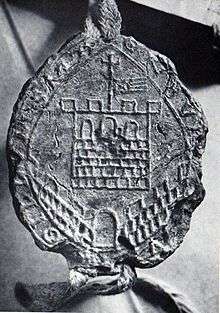
In 1072 a Benedictine monastery of Grafschaft was founded near the Wilzenberg mountain by St. Anno II, Archbishop of Cologne.
[7] The oldest available documents speaking of a “Town of Schmallenberg” are the archbishop's and the town council's deeds from 1243. There were several causes which let the place of “Smalenburg” (old German, “narrow castle”) receive town rights.
[8] Before Schmallenberg received town rights, there had been a castle of Schmallenberg which must have been destroyed around 1240. It was owned by the Archbishop of Cologne Conrad of Hochstadt and the Grafschaft Abbey. The Knight Johann Kolve had the order to protect this castle. At this time, there already must have been some kind of settlement around. The archbishop did not consider the destroyed castle as useful any more. Furthermore, the local settlement was unprotected and in a risky situation because of the castle. That is why the archbishop and the Grafschaft Abbey wanted to fortify the place, leaving the old castle outside the town wall.
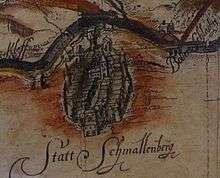
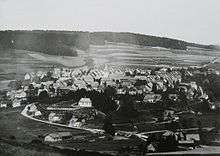
In 1244 Schmallenberg received town rights and got a mayor and an own council. Johann Kolve, who had recommended this solution, became the commander of the new fortified town. He got 30 shillings every year on St. Martin’s Day as an indemnity, an own property and a judicial immunity was granted. The new Town of Schmallenberg thanked Kolve for its new protecting wall. He did not have to pay taxes and did not have any civic duties.
There is evidence from 1273 and 1292 of blacksmiths working in Schmallenberg and there have been cutlers and trip hammers for a long time. The town joined alliances with Medebach, Hallenberg and Winterberg and was a member of the Hanseatic League. It used to be a Colognian minting place in the 13th century. After weapon techniques had changed and to the archbishop, Schmallenberg had lost its fortified status, the town went through an economical crisis in the 16th century.
In 1812, the wall and its gates were torn down. In the last of the three big fires of 1732, 1746 and 1822, 131 of 151 houses burnt down and Schmallenberg was rebuilt in the now characteristic structure (“Prussian ladder system”) with its half-timbered houses and slated roofs.
[9] In 1800, the iron manufacturing was the second biggest in the whole Duchy of Westphalia. When it collapsed because of major competition and high costs, textile industry developed in Schmallenberg. There had already been seven companies belonging to textile industry in 1871. Manufacturing different kinds of textile should become the most important business type for the following years.
Economy
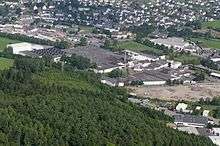
Since the 19th century Schmallenberg traditionally was one of the Sauerland's centers of textile industry. The largest company today is the Falke company. That's why the town received the nickname die Strumpfstadt (“the sock town”). Today, 25 per cent of the population work in forest and wood economy or in tourism.[10] In 2002 there were 7,924 jobs based on social insurances.[11]
Major Schmallenberg companies are:
- FALKE-GROUP (English) (textile industry, 2015: 3,366 employees)
- Burgbad AG (English) (Hidden champions, bathroom furniture manufacturer with headquarters in Bad Fredeburg, 2011: 740 employees)
- Feldhaus (German) (construction company, 2014: 650 employees)
Fraunhofer Society

The Fraunhofer Institute for Molecular Biology and Applied Ecology (IME) conducts research in the field of applied life sciences from a molecular level to entire ecosystems. The IME (English) has around 140 employees working at its locations in Schmallenberg and Aachen.
Transport
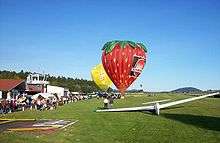
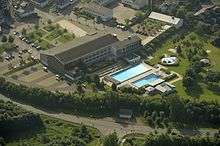
Air transport
Airfield
Schmallenberg’s aerodrome is the Rennefeld motorsport and glider airfield (German) (Motorsport- und Segelflugplatz Rennefeld) between the villages of Wormbach and Werpe. ICAO-Code: EDKR (German).
Airports
The town is surrounded by the following airports (near to far): Paderborn/Lippstadt (PAD), Dortmund (DTM), Kassel (KSF), Cologne/Bonn (CGN), Münster/Osnabrück (FMO), Düsseldorf (DUS) and Frankfurt am Main (FRA).
Private transport
Federal highways
![]()
![]() The federal highways (Bundesstraßen) B 236 and B 511 run through the town's territory.
The federal highways (Bundesstraßen) B 236 and B 511 run through the town's territory.
Autobahn
The Autobahn closest to Schmallenberg is the one in
Other close junctions to different directions can be found in
-
 Olpe, Olpe junction (27 mi/43 km for the A 45 to either Frankfurt am Main/Cologne or Dortmund)
Olpe, Olpe junction (27 mi/43 km for the A 45 to either Frankfurt am Main/Cologne or Dortmund) -
 Wenden (Sauerland), Krombach junction (27 mi/43 km for the A 4 to Cologne/Frankfurt am Main/Dortmund/Olpe/A 4/A 45)
Wenden (Sauerland), Krombach junction (27 mi/43 km for the A 4 to Cologne/Frankfurt am Main/Dortmund/Olpe/A 4/A 45) -

 Bad Wünnenberg, Kreuz Wünnenberg-Haaren junction (43 mi/69 km for the A 33 to Bielefeld/Paderborn or the A 44 to either Kassel or Dortmund/Airport)
Bad Wünnenberg, Kreuz Wünnenberg-Haaren junction (43 mi/69 km for the A 33 to Bielefeld/Paderborn or the A 44 to either Kassel or Dortmund/Airport)
Public transport
Trains
The closest train stations are the ones in Lennestadt-Altenhundem, Meschede and Winterberg.
Buses
Buses of Busverkehr Ruhr-Sieg (BRS) serve the town on the main routes. An association only founded for this purpose voluntarily provides a Bürgerbus (“civic bus”) on the less common routes. It mainly serves the smaller villages.
Media
The Westfalenpost newspaper has editorial offices in Schmallenberg and Meschede and issues a daily local edition from Mondays to Saturdays. It shares its local edition with the Westfälische Rundschau which is another daily newspaper. The free advertising newspaper Sauerlandkurier also has an editorial office in Schmallenberg and is being issued on Wednesdays and Sundays.
Radio and TV news can be received from the West German Broadcasting (WDR). There is a WDR regional studio in Siegen which daily broadcasts news for South Westphalia on WDR 2 radio (on 93.8 FM) and in the Lokalzeit show for South Westphalia on television (WDR Fernsehen). Another local radio channel is Radio Sauerland from Meschede which can be received at 89.1 or 106.5 FM in Schmallenberg and on different frequencies in the whole High Sauerland District.
The above-mentioned media each have a website providing (German) news online:
Education
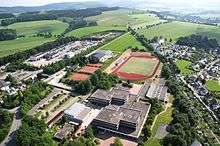
[12] Schmallenberg has seven elementary schools (Grundschulen) and three secondary schools (a Hauptschule, a Realschule and a Gymnasium).
There is also one special school of the High Sauerland District for emotional and social development, elementary and secondary level one (Martinsschule Dorlar), one folk high school (Volkshochschule) and a district's school of music (Kreismusikschule).
Culture
Starting from Schmallenberg central town, trips to the Nordenau Rappelstein castle ruin with great views, the Grafschaft Abbey or to the nearby Kneipp health resort of Bad Fredeburg are always worth to do. There are some local museums like the Slate Mining and Home Region Museum in Holthausen, the Hesse Cutlery Factory in Fleckenberg, the Monastery Museum in Grafschaft or the Jurisdiction Museum in Bad Fredeburg.
Annual events in many places in town are the marksmen's festivals (Schützenfeste) lasting two to four days between April and August. They celebrate the local traditions including parades, traditional music and dance in a local hall or tent and a shooting of a wooden bird. There are 20 marksmen's clubs (Schützenvereine) in town and each has its own Schützenfest.[13] The biggest club is the Schmallenberg Marksmen's Society 1820 (Schützengesellschaft Schmallenberg 1820). The oldest Schützenverein in the modern Town of Schmallenberg is the Wormbach St. Judoc Marksmen's Fraternity (St.-Jodokus-Schützenbruderschaft Wormbach). It was founded in 1525.
[14] Schmallenberg's town festival is the Schmallenberger Woche (“the Schmallenberg week”) and is being held every two years from a Wednesday to a Sunday in August. This event is celebrated in central Schmallenberg's old town and turns the Marksmen's Square park (Parkanlage Schützenplatz) and the Weststraße and Oststraße into a pedestrian area with music, entertainment and several stalls providing food, drinks, other commercial goods and information. Citizens from many of Schmallenberg's places, the twin towns and several associations take part in the festival.
On each Second Sunday of Advent and Friday and Saturday before there is a Christmas market around the central town's Catholic church.[15] Further Christmas markets can be found on different dates in other places of the town.
Sport

Schmallenberg has many hiking trails adding up to approximately 2,500 kilometers, leading through forests, across mountains and through valleys. The Rothaarsteig, a hiking trail along the Rothaar Mountains from Brilon to Dillenburg, leads through the town's territory. Recently, the town at the upper course of the Lenne River has developed into one of Westphalia's winter sport centers. The Nordic Center of North Rhine-Westphalia and the High Sauerland Cross-Country Skiing Center are both located in Westfeld. 250 kilometers of cross-country ski tracks and 30 ski lifts make any kind of skiing possible.
Notable people
- Tom Astor (born February 27, 1943 in Schmallenberg) is a German singer and composer.
- Franziskus Hennemann (27 October 1882 – 17 January 1951 born in Schmallenberg-Holthausen) was a Titular Bishop in South Africa.
References
- ↑ "Amtliche Bevölkerungszahlen". Landesbetrieb Information und Technik NRW (in German). 18 July 2016.
- ↑ Stadt Schmallenberg: Kurorte (German)
- ↑ Schmallenberger Sauerland: Golddörfer Schmallenberg und Eslohe (German)
- ↑ Distances measured with Google Maps.
- ↑ Stadt Schmallenberg: Hauptwohnsitze zum 31.12.2013 (German)
- ↑ Stadt Schmallenberg, Hauptsatzung (German)
- ↑ Johannes Bauermann: Die Schmallenberger Stadturkunden. Erschienen in: „Beiträge zur Geschichte der Stadt Schmallenberg 1244 – 1969“ im Selbstverlag der Stadt Schmallenberg (German)
- ↑ Carl Haase: Schmallenberg im Rahmen der Geschichte der deutschen Stadt. Erschienen in: „Beiträge zur Geschichte der Stadt Schmallenberg 1244 – 1969“ im Selbstverlag der Stadt Schmallenberg (German)
- ↑ Horst Becker: Beiträge zur Entstehung der Schmallenberger Textilindustrie. Erschienen in: „Beiträge zur Geschichte der Stadt Schmallenberg 1244 – 1969“ im Selbstverlag der Stadt Schmallenberg (German)
- ↑ Verkehrsverein Schmallenberg: Holz- und Touristikzentrum (German)
- ↑ Peter Kracht: Sauerland, Siegerland und Wittgensteiner Land, Verlag Aschendorff, Münster, ISBN 3-402-05497-3 (German)
- ↑ Stadt Schmallenberg: Schulen (German)
- ↑ Kreisschützenbund Meschede: Stadt Schmallenberg (German)
- ↑ Verkehrsverein Schmallenberg: Schmallenberger Woche (German)
- ↑ Werbegemeinschaft Schmallenberg: Aktuelles und Infos (German)
External links
| Wikimedia Commons has media related to Schmallenberg. |
- Town administration of Schmallenberg (German)
- Schmallenberg Tourism (German)
- Sauerland Tourism (German)


